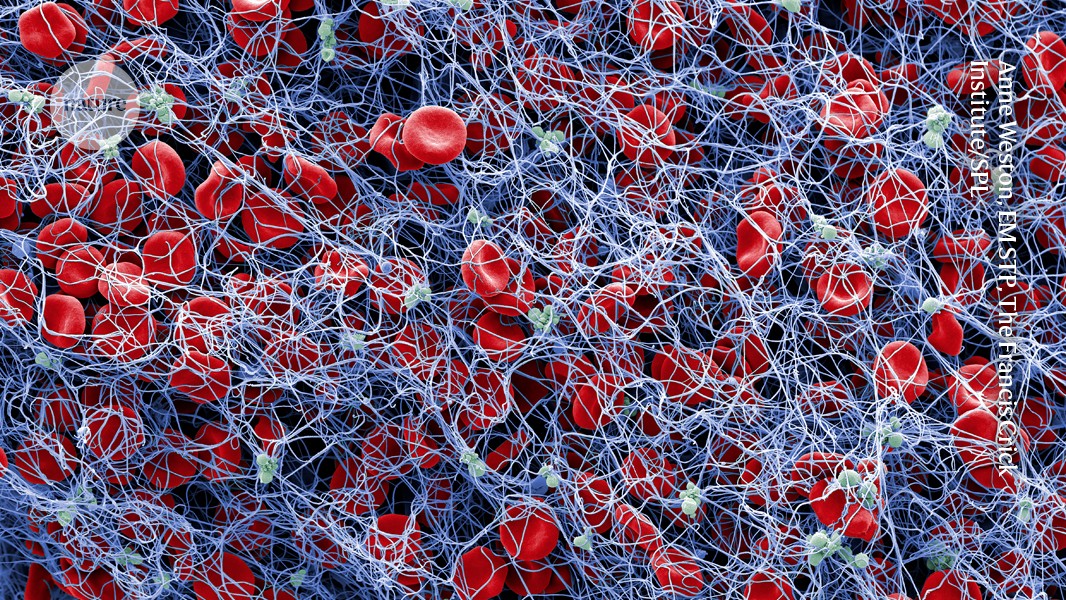'Neural tourniquet’ controls bleeding with nerve stimulation

Applying electrical stimulation to a major nerve that runs from the brain to the body might help to promote clotting

Platelets and red blood cells mingle in a blood clot (artificially coloured).Credit: Anne Weston, EM STP, The Francis Crick Institute/Science Photo Library
Chicago, Illinois
Forget the gauze and bandages: electrical stimulation near the ear might help to reduce bleeding. Researchers hope the technique could one day be used before surgery, childbirth and other events that pose a risk of dangerously uncontrolled bleeding.
The treatment, called a ‘neural tourniquet’ by its creators, helps to turbocharge the activity of platelets, which are cell fragments that form blood clots, according to preliminary results presented at the 2024 Society for Neuroscience conference.
“Anybody who’s worked in the emergency or operating room knows how gruesome it can be to lose somebody to bleeding,” Jared Huston, a trauma surgeon at the Feinstein Institutes for Medical Research in Manhasset, New York, who co-developed the treatment, tells Nature. “Bleeding can kill you much faster than sepsis.”
Bleeding’s heavy toll
Haemorrhage, or uncontrolled bleeding, accounts for about 60,000 deaths in the United States each year1. To try to reduce that number, Huston and his colleagues are developing a treatment that targets the vagus nerves, which are large networks of nerve fibres that link the body with the brain. Despite its name, the treatment does not work like a typical tourniquet that blocks blood flow to injured appendages. Instead, the electrical pulses help to stimulate the spleen, which stores about one-third of the body’s platelets. The stimulation prods the spleen to ready platelets to form a clot.
To test the treatment, the researchers made small cuts in the ears of healthy pigs2. Compared with animals that didn’t receive the treatment, treated swine lost 50% less blood, and the duration of their bleeding was 40% shorter.
The team also tested the treatment on mice with haemophilia, a condition in which the blood does not clot properly, and found similar results3. The experiment also hinted at how nerve stimulation achieves these results: it increases calcium uptake by platelets in the spleen and makes them more ready to release their innards when they reach an injured blood vessel. Both actions are key to clot formation.
Last year, Huston and Spark Biomedical, a biotechnology firm based in Dallas, Texas, launched a trial of the treatment in 30 people. In some participants, the researchers applied mild electric currents to one of two stimulation sites near the ear; control participants received sham stimulation. The preliminary results show that the treatment modestly increases clot stability and platelet activation.
Platelets’ slow start
The treatment’s time scale could be a problem: platelets were most highly activated 2 hours after stimulation — which might make the device impractical for use in the emergency room. Huston is still analysing data about whether the treatment could lead to excessive clotting elsewhere in the body, but he says that nerve stimulation has been used safely for decades, giving him no reason for concern.
It’s also unclear whether increased clot stability will translate into decreased bleeding in people, says Svetlana Mastitskaya, a cardiovascular neuroscientist at the University of Bristol, UK. “It would be nice to see a more visible effect of the intervention,” she says.
Huston responds that bleeding time and volume are harder to study in people than in animals, because of ethical concerns about intentionally harming humans. Still, it might be possible to determine the treatment’s effectiveness by studying people with haemophilia or who are about to undergo surgery.
Researchers are also testing the device in women with type 1 von Willebrand disease, who often experience excessive menstrual bleeding and lose as much as a litre of blood during menstruation, says Spark Biomedical’s chief scientific officer, Navid Khodaparast. Participants receive one hour of stimulation twice a day in a bid to reduce their bleeding. Results are forthcoming, he says.
doi: https://doi.org/10.1038/d41586-024-03330-4
This story originally appeared on: Nature - Author:Max Kozlov


















